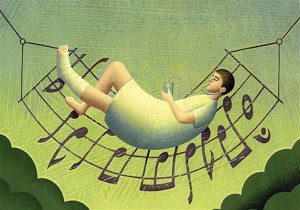Guest Writer for Wake Up World
If you’re going to be undergoing a medical procedure, or you struggle with chronic pain, reaching for your playlist may be as good as reaching for a bottle of pain pills.
The power of music for relaxation, stress relief, and pain reduction is undeniable, although individual research studies proving the same were too small to show a strong connection. That all changed when researchers pooled the data from 73 randomized clinical trials focusing on the role of music among surgery patients. Researcher Dr. Catherine Meads at Brunel University told NPR:1
“As the studies themselves were small, they really didn’t find all that much… But once we put them all together, we had much more power to find whether music worked or not.”
[pro_ad_display_adzone id=”110028″]
Music Reduces Pain Before, During, and After Surgery
Given that music is non-invasive, safe, and inexpensive – and most people find it enjoyable – the researchers suggested hospitals should routinely offer it to patients. The study found music helped patients drop an average of two points on a 10-point pain scale, while also using significantly less pain medication.
This level of relief is comparable to that achieved by a dose of pain-relieving drugs. In addition to reductions in pain, less anxiety and more patient satisfaction were also noted.
Benefits were found when music was played before, during, or after surgery, and even music played while patients were under general anesthetic was effective. Although in many cases the patients themselves chose the music, music was beneficial regardless of the type of music played or who selected it.
About the only downside noted was that several studies found music played in operating rooms may make it harder for surgical staff to hear directions, potentially increasing the risk of errors. This can be remedied by reserving the music for before and after the actual procedure.
Music Works Better Than Anti-Anxiety Drugs
After reviewing 400 studies, another meta-analysis revealed listening to music resulted in less anxiety and lower cortisol levels among patients about to undergo surgery than taking anti-anxiety drugs.2
Other evidence showed music has an impact on antibodies linked to immunity and may lead to higher levels of bacteria-fighting cells. Still more research revealed that playing music in the neonatal intensive care unit (NICU) improved the health of premature babies with respiratory distress or sepsis.3
When parents sang to their babies, or sounds mimicking those in the womb were played, numerous benefits occurred, including changes in heart rates, sucking behavior, and parents’ stress levels. The researchers noted:
“Entrained with a premature infant’s observed vital signs, sound and lullaby may improve feeding behaviors and sucking patterns and may increase prolonged periods of quiet–alert states. Parent-preferred lullabies, sung live, can enhance bonding, thus decreasing the stress parents associate with premature infant care.”
How Does Music Help with Pain and Anxiety Relief?
While some have suggested music serves as a distraction from pain, others believe there are intrinsic qualities in music that make it so effective. Music has been used since ancient times as a form of healing; even the ancient Greek philosopher Pythagoras reportedly used stringed instruments to practice “musical medicine.”4
It’s now known, however, that music triggers activity in the nucleus accumbens, a part of your brain that releases the feel-good chemical dopamine and is involved in forming expectations.
At the same time, the amygdala, which is involved in processing emotion, and the prefrontal cortex, which controls abstract decision-making, are also activated, according to research published in the journal Science.5
Based on the brain activity in certain regions, especially the nucleus accumbens, captured by an fMRI imager while participants listened to music, the researchers could predict how much money the listeners were willing to spend on previously unheard music.
Songs that triggered activity in the emotional and intellectual areas of the brain demanded a higher price.
Interestingly, the study’s lead author noted that your brain learns how to predict how different pieces of music will unfold using pattern recognition and prediction, skills that may have been key to our evolutionary progress. Time reported:6
“These predictions are culture-dependent and based on experience: someone raised on rock or Western classical music won’t be able to predict the course of an Indian raga, for example, and vice versa.
But if a piece develops in a way that’s both slightly novel and still in line with our brain’s prediction, we tend to like it a lot. And that, says [lead researcher] Salimpoor, ‘is because we’ve made a kind of intellectual conquest.’
Music may, in other words, tap into a brain mechanism that was key to our evolutionary progress. The ability to recognize patterns and generalize from experience, to predict what’s likely to happen in the future — in short, the ability to imagine — is something humans do far better than any other animals. It’s what allowed us (aided by the far less glamorous opposable thumb) to take over the world.”
Music Therapy Is a Growing Field
Music therapy is a bona fide profession that’s been around since the 20th century (although, as mentioned, the use of music for healing has been going on for centuries). According to the American Music Therapy Association (AMTA):7
“The 20th century discipline began after World War I and World War II when community musicians of all types, both amateur and professional, went to Veterans hospitals around the country to play for the thousands of veterans suffering both physical and emotional trauma from the wars.
The patients’ notable physical and emotional responses to music led the doctors and nurses to request the hiring of musicians by the hospitals. It was soon evident that the hospital musicians needed some prior training before entering the facility and so the demand grew for a college curriculum.
The first music therapy degree program in the world, founded at Michigan State University in 1944, celebrated its 50th anniversary in 1994.”
There are numerous ways to use music in the health care field. For instance, exposure to music may help people with Alzheimer’s disease to overcome neurolinguistic limitations, such as including more meaningful words and complex grammar when recalling memories.
[pro_ad_display_adzone id=”110030″]
When Alzheimer’s patients sat in rooms filled with music and were asked to tell a story about their life, their stories contained more meaningful words, were more grammatically complex, and conveyed more information (per number of words) than stories told in a silent room.8,9
This makes sense, as the study’s co-author noted, because “music and language processing share a common neural basis.”10 It’s long been theorized that listening to music may boost your brainpower; you’ve probably heard of this with the “Mozart Effect,” which suggests listening to classical music can make you smarter.
Indeed, research has shown listening to music while exercising boosts cognitive levels and verbal fluency skills in people diagnosed with coronary artery disease (coronary artery disease has been linked to a decline in cognitive abilities). Signs of improvement in the verbal fluency areas more than doubled after listening to music compared to that of the non-music session.11 In addition, AMTA notes that music therapy may be useful for the following:
| Alleviating acute and chronic pain | Elevating mood | Counteracting depression |
| Promoting movement for physical rehabilitation | Calming or sedation | Inducing sleep |
| Counteracting apprehension or fear | Lessening muscle tension | Relaxation, including the autonomic nervous system |
| Strengthening communication skills | Improving physical coordination among special needs students | Exploring personal feelings |
| Making positive changes in mood and emotional states | Increase or maintain physical, mental, and social/emotional functioning in the elderly | Vital support for physical exercise |
| Stress reduction | Assistance during labor and delivery | Substance abuse problems |
| Brain injuries | Developmental and learning disabilities |
Suffering from Chronic Pain? Try Music
While you can seek out a music therapist to work with you on an individual health problem, you’re free to use music to your advantage whenever the mood strikes. And, of course, it’s not only useful for surgical pain but can also be used to help relieve chronic pain as well. Technology has given us a simple way to harness the power of music by allowing you to create different playlists for exercising, relaxing, working, pain reduction, stress relief, and other important aspects of your day so you can instantly access the right music for your mood or activity.
Most studies suggest that it doesn’t matter what type of music you listen to, so just choose the types that appeal to you most. About the only exception is during exercise, when a faster tempo may be best. For instance, in one study when the music’s tempo slowed, the subjects’ exertion level reduced as well.12 And when the tempo was increased, their performance followed suit. So a faster temp should help keep up your intensity.
Outside of exercise, only you know the “best” music for you and that will inevitably change – not only day to day with your mood but also over time with the different chapters of your life and health challenges you may be addressing. Recent research suggests a striking number of Americans – more than 25 million – suffer from daily pain, and 14.4 million describe the pain as being severe.13 Oftentimes prescription drugs aren’t enough to control the pain, and they carry steep side effects, so alternative treatments are welcomed. Listening to music is one such alternative that is safe and available to virtually everyone.
Are You in Pain? Try This Before Drugs
If you are dealing with severe or chronic pain, my first suggestion would be to see a pain specialist who is familiar with alternative treatments and the underlying causes of pain. You need a knowledgeable practitioner who can help you attack the pain from multiple angles, giving you both relief and healing. This might involve music therapy or a combination of strategies, including those that follow:
- Eliminate or radically reduce most grains and sugars from your diet. Avoiding grains and sugars will lower your insulin and leptin levels and decrease insulin and leptin resistance, which is one of the most important reasons why inflammatory prostaglandins are produced. That is why stopping sugar and sweets is so important to controlling your pain and other types of chronic illnesses.
- Take a high-quality, animal-based omega-3 fat. My personal favorite is krill oil. Omega-3 fats are precursors to mediators of inflammation called prostaglandins. (In fact, that is how anti-inflammatory painkillers work, they manipulate prostaglandins.)
- Optimize your production of vitamin D by getting regular, appropriate sun exposure, which will work through a variety of different mechanisms to reduce your pain.
- Emotional Freedom Technique (EFT) is a drug-free approach for pain management of all kinds. EFT borrows from the principles of acupuncture, in that it helps you balance out your subtle energy system. It helps resolve underlying, often subconscious, and negative emotions that may be exacerbating your physical pain. By stimulating (tapping) well-established acupuncture points with your fingertips, you rebalance your energy system, which tends to dissipate pain.
- K-Laser Class 4 Laser Therapy. If you suffer pain from an injury, arthritis, or other inflammation-based pain, I’d strongly encourage you to try out K-Laser therapy. It can be an excellent choice for many painful conditions, including acute injuries. By addressing the underlying cause of the pain, you will no longer need to rely on painkillers. K-Laser is a class 4 infrared laser therapy treatment that helps reduce pain, reduce inflammation, and enhance tissue healing — both in hard and soft tissues, including muscles, ligaments, or even bones. The infrared wavelengths used in the K-Laser allow for targeting specific areas of your body, and can penetrate deeply into the body to reach areas such as your spine and hip. For more information about this groundbreaking technology, and how it can help heal chronic pain, please listen to my previous interview with Dr. Harrington.
- Chiropractic. Many studies have confirmed that chiropractic management is much safer and less expensive than allopathic medical treatments, especially when used for pain, such as low-back pain. Qualified chiropractic, osteopathic, and naturopathic physicians are reliable, as they have received extensive training in the management of musculoskeletal disorders during their course of graduate healthcare training, which lasts between four to six years. These health experts have comprehensive training in musculoskeletal management.
- Acupuncture can also effectively treat many kinds of pain. Research has discovered a “clear and robust” effect of acupuncture in the treatment of: back-, neck-, and shoulder pain, osteoarthritis, and headaches.
- Physical and massage therapy has been shown to be as good as surgery for painful conditions such as torn cartilage and arthritis.
- Astaxanthin is one of the most effective fat-soluble antioxidants known. It has very potent anti-inflammatory properties and in many cases works far more effectively than anti-inflammatory drugs. Higher doses are typically required and you may need 8 mg or more per day to achieve this benefit.
- Ginger: This herb has potent anti-inflammatory activity and offers pain relief and stomach-settling properties. Fresh ginger works well steeped in boiling water as a tea or grated into vegetable juice.
- Curcumin: In a study of osteoarthritis patients, those who added 200 mg of curcumin a day to their treatment plan had reduced pain and increased mobility. A past study also found that a turmeric extract composed of curcuminoids blocked inflammatory pathways, effectively preventing the overproduction of a protein that triggers swelling and pain.14
- Boswellia: Also known as boswellin or “Indian frankincense,” this herb contains specific active anti-inflammatory ingredients. This is one of my personal favorites as I have seen it work well with many rheumatoid arthritis patients.
- Bromelain: This enzyme, found in pineapples, is a natural anti-inflammatory. It can be taken in supplement form but eating fresh pineapple, including some of the bromelain-rich stem, may also be helpful.
- Cetyl Myristoleate (CMO): This oil, found in fish and dairy butter, acts as a “joint lubricant” and an anti-inflammatory. I have used this for myself to relieve ganglion cysts and a mild annoying carpal tunnel syndrome that pops up when I type too much on non-ergonomic keyboards. I used a topical preparation for this.
- Evening Primrose, Blackcurrant, and Borage Oils: These contain the essential fatty acid gamma linolenic acid (GLA), which is useful for treating arthritic pain.
- Cayenne Cream: Also called capsaicin cream, this spice comes from dried hot peppers. It alleviates pain by depleting the body’s supply of substance P, a chemical component of nerve cells that transmits pain signals to your brain.
- Medical cannabis has a long history as a natural analgesic,15 and many US states have legalized cannabis for medical purposes. Its medicinal qualities are due to high amounts (about 10 to 20 percent) of cannabidiol (CBD), medicinal terpenes, and flavonoids. As discussed in this previous post, varieties of cannabis exist that are very low in tetrahydrocannabinol (THC) — the psychoactive component of marijuana that makes you feel “stoned” — and high in medicinal CBD. The Journal of Pain,16 a publication by the American Pain Society, has a long list of studies on the pain-relieving effects of cannabis.
- Methods such as yoga, Foundation Training, acupuncture, meditation, hot and cold packs, and other mind-body techniques can also result in astonishing pain relief without any drugs.
- Grounding, or walking barefoot on the earth, may also provide a certain measure of pain relief by combating inflammation.
Article sources:
- The Lancet August 13, 2015
- The Journal of Pain August 2015
- NPR August 13, 2015
- CTV News August 13, 2015
- WebMD August 11, 2015
- 1 NPR August 13, 2015
- 2 Trends in Cognitive Sciences April 2013, Volume 17, Issue 4 179-193, 1
- 3 Pediatrics April 15, 2013
- 4 CTV News August 13, 2015
- 5 Science April 12, 2013; 340(6129):216-9.
- 6 Time April 15, 2013
- 7 American Music Therapy Association, FAQ’s
- 8 Journal of Neurolinguistics Volume 26, Issue 6, November 2013, Pages 691–700
- 9, 10 Scientific American June 12, 2014
- 11 Heart Lung. 2003 Nov-Dec;32(6):368-73.
- 12 Scand J Med Sci Sports. 2010 Aug;20(4):662-9. Epub 2009 Sep 28.
- 13 The Journal of Pain August 2015
- 14 Arthritis & Rheumatism, Volume 54, Issue 11, pages 3452–3464, November 2006
- 15 Journal of Pain April 2004: 5(3); S52
- 16 Journal of Pain, Cannabis studies
Previous articles by Dr. Mercola:
- Scientific Review Shows Flouridation Does Not Reduce Cavities
- Scientific Links Between Processed Foods and Depression
- The Aspartame End Game… and What’s Next
- Neil Young, Pope Francis and 100,000 Beekeepers Take a Stand Against Toxic Agriculture
- The Surprising Ways in Which Fast Food and its Packaging Harms Your Health
- How Sugar Harms Your Brain Health and Drives Alzheimer’s Epidemic
- The Health Benefits of Intermittent Fasting
- Sleep Loss May Cause Brain Damage and Accelerate Onset of Alzheimer’s, Two New Studies Show
- Can a Hug a Day Keep Infection Away?
- The Fluoride Deception Continues as US Government Ignores Fluoride’s Role as an Endocrine Disruptor
- Magnesium: An Invisible Deficiency That Could Be Harming Your Health
About the author:
 Born and raised in the inner city of Chicago, IL, Dr. Joseph Mercola is an osteopathic physician trained in both traditional and natural medicine. Board-certified in family medicine, Dr. Mercola served as the chairman of the family medicine department at St. Alexius Medical Center for five years, and in 2012 was granted fellowship status by the American College of Nutrition (ACN).
Born and raised in the inner city of Chicago, IL, Dr. Joseph Mercola is an osteopathic physician trained in both traditional and natural medicine. Board-certified in family medicine, Dr. Mercola served as the chairman of the family medicine department at St. Alexius Medical Center for five years, and in 2012 was granted fellowship status by the American College of Nutrition (ACN).
While in practice in the late 80s, Dr. Mercola realized the drugs he was prescribing to chronically ill patients were not working. By the early 90s, he began exploring the world of natural medicine, and soon changed the way he practiced medicine.
In 1997 Dr. Mercola founded www.Mercola.com, which is now routinely among the top 10 health sites on the internet. His passion is to transform the traditional medical paradigm in the United States. “The existing medical establishment is responsible for killing and permanently injuring millions of Americans… You want practical health solutions without the hype, and that’s what I offer.”
Visit www.Mercola.com for more information, or read Dr. Mercola’s full bio and résumé here.
[pro_ad_display_adzone id=”110027″]









